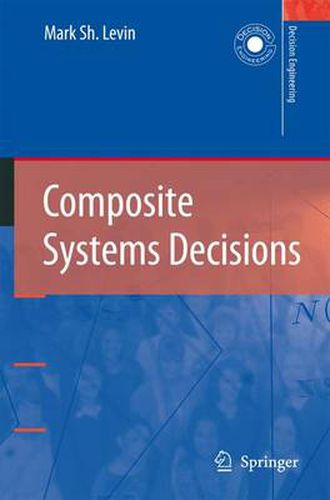Readings Newsletter
Become a Readings Member to make your shopping experience even easier.
Sign in or sign up for free!
You’re not far away from qualifying for FREE standard shipping within Australia
You’ve qualified for FREE standard shipping within Australia
The cart is loading…






This title is printed to order. This book may have been self-published. If so, we cannot guarantee the quality of the content. In the main most books will have gone through the editing process however some may not. We therefore suggest that you be aware of this before ordering this book. If in doubt check either the author or publisher’s details as we are unable to accept any returns unless they are faulty. Please contact us if you have any questions.
NEEDS TO BE CUT DOWNComposite decisions are decisions consisting of interconnected subdecisions which correspond to a composite system. This approach extends the traditional paradigm of decision making proposed by Herbert A. Simon (choice of the best alternatives) and realizes the two-stage solving scheme: (a) selection of alternatives as the best subdecisions and (b) composition of the selected local decisions into a global decision; while taking into account the quality of the local decisions and their compatibility. Composite Systems Decisions can be considered as the continuation of the author’s monograph Combinatorial Engineering of Decomposable Systems (Kluwer, 1998). Basic ‘technological’ problems for composite systems are examined, including: modular hierarchical design; multistage design; multistage planning; redesign / improvement / adaptation; evaluation; combinatorial evolution /development. The book is oriented to applied researchers, students, and practitioners in many domains. Concurrently, the material will be of interest to various scientists (e. g. , mathematicians, computer scientists, economists, social engineers,etc. ) who can refer to the basic systems problems, solving schemes, and applied examples. The book can be used as a text for courses (for example: systems engineering, system design, life cycle engineering, engineering design, combinatorial synthesis) at the level of undergraduate (a compressed version), graduate/PhD levels and for continuing education. Note special student team research projects can be included into an educational plans. The student teams above can involve students of different professional domains. In addition, the material will be useful for the modular curriculum design.
$9.00 standard shipping within Australia
FREE standard shipping within Australia for orders over $100.00
Express & International shipping calculated at checkout
This title is printed to order. This book may have been self-published. If so, we cannot guarantee the quality of the content. In the main most books will have gone through the editing process however some may not. We therefore suggest that you be aware of this before ordering this book. If in doubt check either the author or publisher’s details as we are unable to accept any returns unless they are faulty. Please contact us if you have any questions.
NEEDS TO BE CUT DOWNComposite decisions are decisions consisting of interconnected subdecisions which correspond to a composite system. This approach extends the traditional paradigm of decision making proposed by Herbert A. Simon (choice of the best alternatives) and realizes the two-stage solving scheme: (a) selection of alternatives as the best subdecisions and (b) composition of the selected local decisions into a global decision; while taking into account the quality of the local decisions and their compatibility. Composite Systems Decisions can be considered as the continuation of the author’s monograph Combinatorial Engineering of Decomposable Systems (Kluwer, 1998). Basic ‘technological’ problems for composite systems are examined, including: modular hierarchical design; multistage design; multistage planning; redesign / improvement / adaptation; evaluation; combinatorial evolution /development. The book is oriented to applied researchers, students, and practitioners in many domains. Concurrently, the material will be of interest to various scientists (e. g. , mathematicians, computer scientists, economists, social engineers,etc. ) who can refer to the basic systems problems, solving schemes, and applied examples. The book can be used as a text for courses (for example: systems engineering, system design, life cycle engineering, engineering design, combinatorial synthesis) at the level of undergraduate (a compressed version), graduate/PhD levels and for continuing education. Note special student team research projects can be included into an educational plans. The student teams above can involve students of different professional domains. In addition, the material will be useful for the modular curriculum design.